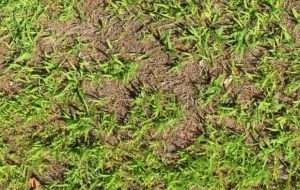How to Get Rid of Crabgrass and Prevent its Return
 A lush, green lawn adds beauty and value to any property. However, unwanted guests like crabgrass can quickly turn your dream lawn into a patchy mess. This persistent weed thrives in warm weather and competes for resources with your desired grass, hindering its growth and impacting the overall aesthetics of your yard. Let us help equip you with the knowledge and tool to combat crabgrass effectively including identification, causes, removal methods, prevention strategies and when to seek professional assistance for comprehensive lawn care solutions.
A lush, green lawn adds beauty and value to any property. However, unwanted guests like crabgrass can quickly turn your dream lawn into a patchy mess. This persistent weed thrives in warm weather and competes for resources with your desired grass, hindering its growth and impacting the overall aesthetics of your yard. Let us help equip you with the knowledge and tool to combat crabgrass effectively including identification, causes, removal methods, prevention strategies and when to seek professional assistance for comprehensive lawn care solutions.
What Does Crabgrass Look Like in a Lawn?
Identifying crabgrass is crucial for targeted removal. Here are some key characteristics that distinguish it from your desired lawn grasses:
- Leaf structure: Unlike your lawn grasses, which have flat blades, crabgrass boasts folded, finger-like leaves. These leaves have a prominent central vein and a lighter, yellowish-green color compared to the deeper green of your lawn grasses.
- Growth pattern: Crabgrass grows in low-lying clumps that spread outward. These clumps have a distinctive fan-like or rosette appearance, often with a reddish tinge at the base of the leaves.
- Root system: Crabgrass has shallow, fibrous roots, unlike the deeper root systems of many lawn grasses. This shallow root system makes it easier to remove crabgrass by hand compared to other weeds.
Why Do I Have Crabgrass?
Several factors can contribute to a crabgrass infestation, though armed with the knowledge and strategies to prevent it, you can help promote a healthy lawn. This includes understanding how mowing can affect the chances of weeds establishing. Mowing your lawn too short weakens the root system of your desired grass, making it vulnerable to invasion by crabgrass seeds. Aim to mow at the recommended height for your specific grass type to promote healthy growth.
A lack of essential nutrients like nitrogen can also weaken your lawn, making it more susceptible to weed invasion. Regularly test your soil and address any nutrient deficiencies with appropriate fertilizers as needed. It’s also really important to apply fertilizers at the right time. Applying nitrogen-rich fertilizers in late summer or fall can actually stimulate crabgrass growth. Typically most fertlizers are best to apply in early spring or fall, depending on the specific grass type.
Crabgrass also thrives if the soil is too dense. This can restrict air and water flow, hindering growth and creating favorable conditions for crabgrass to grow. Aim to aerate your lawn regularly to improve drainage and encourage healthy root growth. Both overwatering and underwatering can also stress your lawn, creating vulnerabilities for crabgrass to establish. Water your lawn deeply and infrequently to encourage deep root growth, making it less susceptible to weeds.
How to Kill Crabgrass
There are two primary approaches to eliminating existing crabgrass in your lawn:
Manual Removal
Timing is key for helping to eliminate Crabgrass. Aim for early spring before crabgrass sets seeds, this gives your desired grass time to recover after the removal process. It’s important to loosen the soil using a trowel or weeding fork around the crabgrass clump, this makes it easier to remove the entire plant. You can then carefully pull the entire crabgrass plant out. Ensure you remove the entire root system to prevent regrowth. You can then dispose of the crabgrass in a sealed trash bag to prevent seed dispersal and further infestation.
Selective Weed Killer
Choose a product labeled for crabgrass: Look for a selective herbicide specifically formulated to target crabgrass while leaving your desired lawn grasses unharmed. It’s crucial to follow the product label religiously, so be sure to carefully read and adhere to all instructions regarding application rates, timing, and safety precautions. Ignoring these instructions can harm your lawn or other surrounding plants.
It’s also important to apply during appropriate conditions, e.g. on a calm day with low wind speeds and no rain expected for at least 24 hours. This helps prevent drift and potential damage to nearby plants.
Preventing Crabgrass from Returning
Consistent care and preventative measures are crucial for a thriving, healthy lawn throughout the seasons. Follow our top tips to help keep crabgrass away:
- Apply a pre-emergent herbicide: This type of herbicide creates a barrier in the soil, preventing crabgrass seeds from germinating. Apply pre-emergent herbicides in early spring, following the specific product instructions. Be mindful of the application window, as applying it too early or too late can be ineffective.
- Maintain proper mowing practices: Mow your lawn at the recommended height for your grass type to promote healthy growth and discourage crabgrass. Mowing at the correct height shades the soil, hindering crabgrass seed germination. Additionally, avoid scalping your lawn by removing no more than one-third of the grass blade height at each mowing.
- Water your lawn correctly: Water deeply and infrequently to encourage deep root growth in your desired grass, making it less susceptible to weeds like crabgrass. Aim for one to two inches of water per week, delivered in one or two deep soakings instead of frequent, shallow watering.
- Address nutrient deficiencies: Regularly test your soil and address any nutrient deficiencies with appropriate fertilizers as needed. A healthy lawn with optimal nutrient levels is better equipped to compete with weeds like crabgrass.
- Overseed bare spots: Crabgrass thrives in bare patches in your lawn. Overseed thin or bare areas with the appropriate grass seed to create a dense, healthy lawn that discourages weed growth naturally. Choose a grass seed variety suitable for your climate and soil conditions.
- Consider natural methods: Some natural approaches can help deter crabgrass. These include:
- Cornmeal gluten meal: This organic weed control option can help suppress crabgrass seed germination when applied in early spring. However, repeated applications may be necessary, and its effectiveness can vary depending on factors like soil type and rainfall.
- Corn gluten feed: Similar to cornmeal gluten meal, corn gluten feed can help suppress crabgrass seed germination. However, it is a less concentrated option and may require more frequent applications.
- Vinegar: While effective on existing crabgrass plants, vinegar is a non-selective herbicide and can harm your desired lawn grasses as well. It’s essential to use caution and spot-treat only individual crabgrass plants with a diluted vinegar solution.
These natural methods are not always effective and can do more harm than good, so it’s always best to consult a lawn care professional who can tackle crabgrass safely and effectively whilst looking after the overall health of your lawn.
Call in the experts
For comprehensive lawn care services and expert advice on crabgrass control and prevention, call our team of experienced professionals. Our team can assess your lawn, identify the best approach for crabgrass removal, and apply the appropriate solutions safely and effectively. We will analyze your soil and provide targeted fertilization plans to ensure your lawn receives the essential nutrients it needs for optimal health and resistance to weeds. We can also provide expert advice on aeration, dethatching and overseeding.
Let our lawn care experts take away the hassle of tackling crabgrass in your lawn and help you to achieve a beautiful, weed-free yard!
Learn more about how to keep your lawn looking lush and green with our comprehensive lawn care guides – visit our lawn learning centre.
How to Get Rid of Crabgrass and Prevent its Return in Orlando FL and surrounding counties
Serving satisfied customers in:


